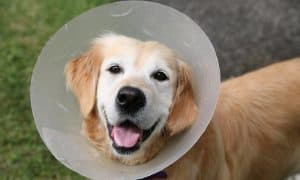“This post contains affiliate links, and I will be compensated if you make a purchase after clicking on my links.”
If you have a dog, you’ve probably encountered a hot spot on his skin at some point. Well, what exactly are hot spots, anyway? Where do they come from? And more importantly, how can we treat them? The dog-loving folks at PetMD solve the mystery for us with this article.
Hot Spots are one of those less then desirable skin irritations seen in pets. Often, you’ll here your vet refer to them as moist eczema, but you … well, you can call them hot spots. They occur when your dog itches, scratches or licks him or herself excessively, eventually forming a wet scab on the fur.
Hot Spots (also known as Summer Sores or Moist Eczema) can seemingly appear spontaneously anywhere on a dog’s body; the surrounding area can rapidly deterioriate too. This moist, raw skin disorder has a variety of causes but the most consistent factor is bacteria.
Anything that irritates or breaks the skin can create the environment for bacterial contamination if the surface of the skin has but only a little a bit of moisture on it. Such incidences of moisture can be such seeminly innocuous things such as as a recent bath, swim, stroll in the rain, or playtime in wet craze. Even a slightly oozing sore can provide enough moisture and/or nutrient for a bacterial infection to take hold.
Although there are various types of “hot spot”-causing bacteria, most respond to oral and topical antibiotics. For some reason, cats rarely acquire hot spots.
How to treat a Hot Spot
- Trim the area around the hot spot with animal clippers. If the area is too big, shave it. Exposing it to air will dry out the moisture and help speed healing.
- Clean the area with a mild water-based astringent or antiseptic spray, or specialized shampoo, and pat dry.
- Apply hydrocortisone spray or hydrocortisone cream (with a veterinarian’s prescription) to stop the itching and help promote healing.
- Prevent your dog from biting, licking or scratching the area. Placing an Elizabethan collar (plastic cone) around your dog’s neck, for example, can be an excellent tool to keep him/her from biting and licking at it.
- Keep an eye on the area to make sure it continues to heal and doesn’t worsen or spread. Hot spots often require a visit to the vet, who will likely prescribe topical medication usually in the form of a Gentamicin / Betamethasone spray, and possibly oral antibiotics. The vet may also give your dog a cortisone injection to jump start the healing process.
Now that you know what exactly hot spots are, you should know if left untreated they can spread very rapidly. Use these tips to keep hot spots under control. You can read the rest of the article here. Do you have a good hot spot remedy not listed above? Tell us about it! Use the comment box below.















beach body home
Jun 24, 2014 at 5:01 pm
I blog often and I seriously appreciate your information. Your article has truly peaked my interest.
I will take a note of your site and keep checking for new
details about once per week. I subscribed to
your RSS feed as well.
nymphomane X
May 7, 2014 at 1:13 am
Je prends la peine de publier cee ƿetit commentaire afin de remercier le webmaster